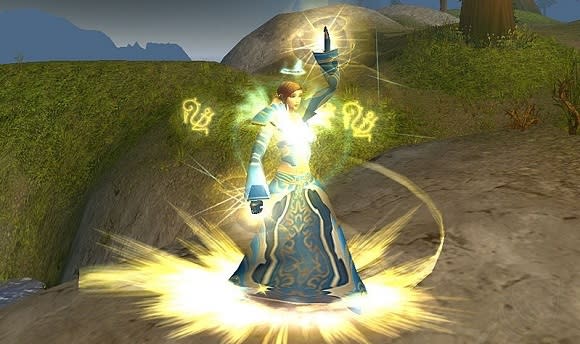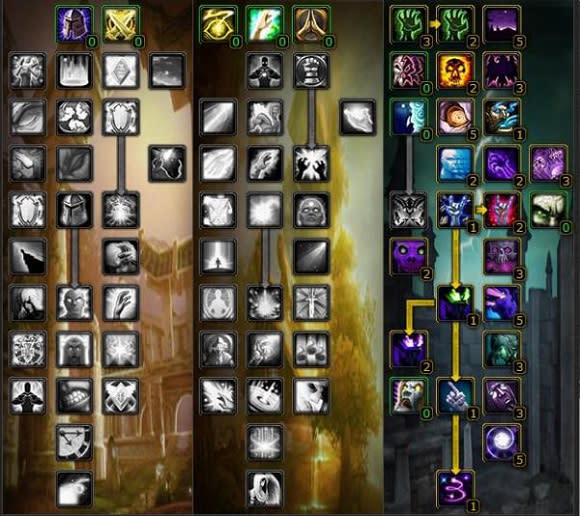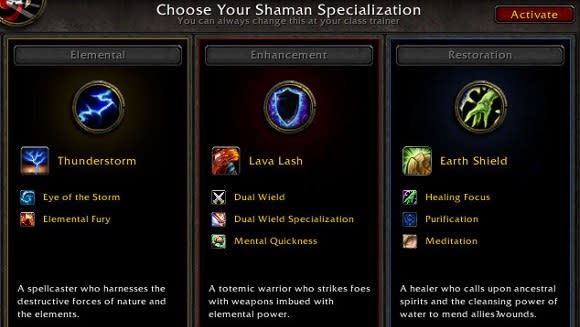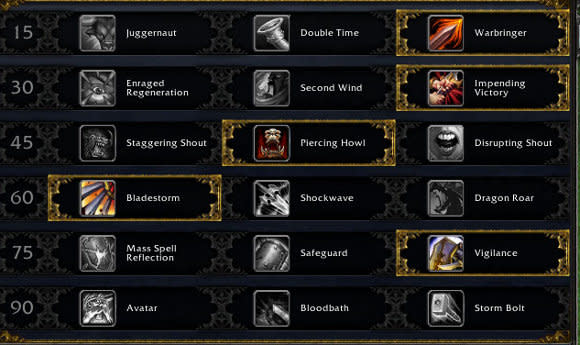WoW Archivist: Talents have come full circle

WoW Archivist explores the secrets of World of Warcraft's past. What did the game look like years ago? Who is etched into WoW's history? What secrets does the game still hold?
The Warlords of Draenor patch 6.0 notes have revealed the latest changes to WoW's ever-evolving talent system. Talents have remained a core system in WoW since its earliest days, the primary method that allows players to make their characters distinct.
In the beta for WoW and throughout vanilla, talent trees were a bit of a mess, as Archivist covered. Today, we'll examine how those early trees came to be expanded, refined, and then scrapped for a very different system. We'll also look at how Warlords is bringing back the earliest version of talent trees in a brand new way.
The golden age of hybrids
Talent possibilities exploded during The Burning Crusade. Ten more levels granted players ten more points to assign. Players could now combine abilities in ways that vanilla's trees had never allowed, opening up exciting new gameplay paths.
Players didn't choose a specialization like they do today. Instead, they assigned points to three different "trees." Each tree represented a spec, but each also had talents that helped the other two specs as well. So players could pick and choose just how far down they wanted to go in a given tree, and thus how much to commit their character to one spec. "Hybrid" builds were not ideal from a min/max perspective, but they were popular. And TBC was the golden age of such builds.
For example, paladins could combine some of retribution's DPS talents with the holy tree's Holy Shock to create a "Shockadin" build. (Holy Shock was a talent.) The build allowed a ranged DPS spec for paladins. It wasn't great for endgame dungeons or raiding, but it was fun to play for questing and PvP.
"Swift Moonkins" could opt for a more resto-heavy build that gave them access to Nature's Swiftness for instant nukes and more healing capabilities, at the cost of their Force of Nature summon spell.
To create such a build, you had to sacrifice acquiring the top-end talents, which were most often powerful new spells. In many cases, however, those 41-point talents were not so amazing that you couldn't live without them. The versatility often made up for the lack of a spec's ultimate spell.
Many classes had viable 40-21 builds in both PvE and PvP, or even wilder splits. Pure DPS classes had even more room for playing around with points, since every tree boosted their damage. For instance, mages created "Frostfire" builds from the Frost and Fire trees before Frostfire was officially a thing. Warlocks had a 30/21/10 build that combined Shadow Mastery with Demonic Sacrifice.
Builds and roles were not as flexible as they are today. You had to visit a trainer and pay gold to reset your trees. The cost of respec'ing rose if you used the service too often. Dual specs did not yet exist. The process was painful and not very fast. So if you went for a hybrid spec, you were fairly committed to it.
Many players who knew they were needed to off-tank certain fights or serve as a backup healer chose hybrid specs that were "good enough" for their main role but allowed them to serve in the other role without the hassle of respec'ing.
Two specs are better than one
In Wrath, Blizzard doubled-down on talent trees. Wrath expanded the trees even further, with another ten points and another layer of talents added at the bottom of each tree.
However, Wrath also introduced Dual Specialization in patch 3.1. The dual spec ability was one of WoW's biggest gamechangers. Suddenly, you could switch from an elemental shaman to a resto shaman on the fly, instead of hearthing to town, resetting your points, respending your points, setting up your bars with the different spells, etc. Players could have separate specs for PvE and PvP. Raiders could set up one talent configuration for single target DPS and one for cleaving down adds.
Blizzard also added the Equipment Manager, which allowed you to save your different sets of armor and weapons for each spec or role. Most players already had an addon for this, but the official one was a great substitute.
Overall, players had far less incentive to use hybrid builds in Wrath. They could change their role to what the raid or the arena team needed with the click of a button. Some players stuck to their hybrid ways, but such builds became more and more fringe.
Meanwhile, the trees had become enormous: 71 points distributed over 11 tiers per tree. Classes had more than 80 different talents to choose from -- almost double the talent choices of classic WoW. Here's what they looked like back then:

That's . . . a lot of icons. Prior to 3.1, remembering where to put all those points was a nightmare. Since dual spec cost 1000g at the time, not everyone was able to afford it even after it was patched in.
Finding ways to balance specs in PvE and PvP was a nightmare, too. Blizzard's devs had to account for every possibility. Blizzard also worried about the perspective of a new player. Wrath had brought in many new subscribers, but the talent trees had sprouted to intimidating heights. Players were greeted at level 10 with labyrinthine towers of icons. Many of them had different numbers of ranks, and some had to be chosen in order to unlock others.
Talent trees had grown beyond Blizzard's ability to control them, and beyond many players' ability to fully grasp.
The Cataclysm pruning
With Cataclysm adding five more levels, players expected even more talent points and, if not new tiers, at least new talents added to existing tiers. After all, that had been the pattern of all the prior expansions.
Blizzard knew that something had to give. They couldn't keep expanding the talent trees forever and hope to overcome both the balance and the new player problems. So instead of expanding the talent trees, they trimmed the trees back down to their vanilla size: seven tiers with 31-point abilities at the end.
The trees had one major difference from vanilla, however. You had to choose a spec and then commit 31 points to that spec's tree before you could branch out to the other two. The spec choice allowed Blizzard to take some of each spec's most iconic abilities, such as Mortal Strike, Lava Lash, or Avenger's Shield, and give them to you for free. That allowed the trees to shrink without sacrificing too many of the spec-defining abilities.
Blizzard wanted talent points to represent meaningful choices. In prior talent designs, most points went to "cookie cutter" talents that added raw damage or healing, like 1% more shadow damage or 2% more healing per point. These were basically mandatory if you wanted a viable character. Thus, every build included them. Blizzard's goal in this expansion was to present players with more opportunities for different, viable specs.
Unfortunately, Cataclysm's trees didn't accomplish this goal. For many specs it had the opposite result. The restriction of putting 31 points into your main spec's tree, combined with many abilities no longer being available from talents, made "cookie cutter" builds even more common. The new system also killed the idea of hybrid builds once and for all.
Despite these problems, players could not imagine talent trees in any other form. Little did we know that Blizzard was laboring away behind the scenes at their most radical redesign in the history of the game.

The Mists talent controversy
BlizzCon 2011's new talent trees may be one of the most shocking revelations that Blizzard has ever made about WoW. Talent points, as a concept, were gone. Talents no longer linked to other talents. There weren't even "trees" anymore -- just tables, with three options for each tier. At the same time, Blizzard expanded the number of spells and passive buffs that you received simply for choosing a given spec.
They seem normal today. But to players who had been putting points into trees since Diablo II, this was a drastic reimagining. Practically nothing of the old talent system remained.
Blizzard said the other trees had offered an illusion of choice while cookie cutter specs dominated the game. With this, they hoped to offer real choices at long last.
Perhaps most drastic of all, the new talent system allowed us to switch our talents on the fly. We no longer had to return to a trainer to switch our allocations from one talent to another within a spec. Different talents could be selected at whim to counter each boss in a raid or to suit different battleground strategies.
Some players loved the concept, but many were (and remain skeptical). It seemed like a lot less customization. Certainly there are fewer overall choices now. For DPS, players argued that the highest DPS talents are always going to be the ones you pick. Some players hated that certain tiers seemed geared only toward PvP or toward PvE. Many predicted the new system would crash and burn, and we'd get a completely different system -- or return to the old one -- in the expansion after Mists.

Full circle in Warlords
That expansion has now been revealed. Blizzard considers the new talent system to be a success, and many players feel the same way. Blizzard has refined the system further to show different talents depending on the spec you're playing at the moment, which will allow for less confusion and more diversity of playstyles within a class.
However, Blizzard revealed another interesting system last week: Draenor perks. These perks are granted to players at random while they level from 91-99. The perks enhance our abilities with damage or healing bonuses, crit chance, reduced cooldowns, bigger resource bars, faster movement, etc.
Reading through this list, it struck me: the perks are like the talent points we used to assign in our old cookie cutter builds. They were so good that it was silly not to take them. Now, instead of making the (non)choice to put points into them, we get them for free. Classes that have multiple trees for the same role do get a choice, since the perks are different for each spec. And we get them one level at a time, just like the old points.
So, in essence, nearly everything that was once part of the original talent trees will be restored to the game at the advent of Warlords: spec-defining abilities, customizable tiers, and major bonuses to key spells. Yes, we now have fewer overall choices as a result, but those choices are more meaningful, as Blizzard intended.
With transmog, cosmetic glyphs, glyphs that change abilities, and talents, we actually have more ways to customize our character inside and out than we ever did before.
At the same time, those choices are also far more temporary than they used to be, so there is some debate about whether they still feel like choices. Talents feel more like tools in a toolbox. Sure, you can only pick a third of the available tools. But you can toss a tool back in the box and get a new one anytime you don't like what you have.
Is this truly a problem, or just a lingering nostalgia for the more commitment-heavy systems of the past? It's something that Blizzard should consider as they look at future iterations of the system.

After months of surveying, WoW Archivist has been dug back up! Discover lore and artifacts of WoW's past, including the Corrupted Blood plague, the Scepter of the Shifting Sands, and the mysterious Emerald Dream.
